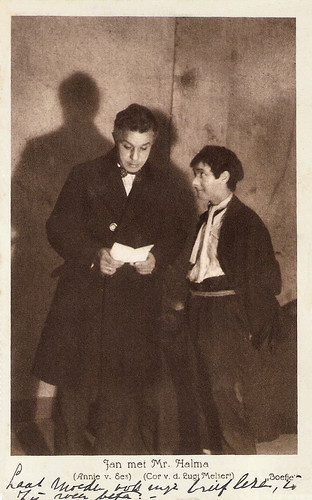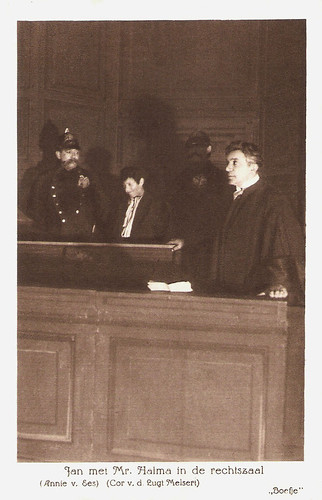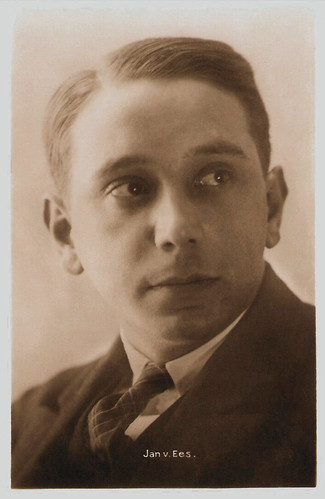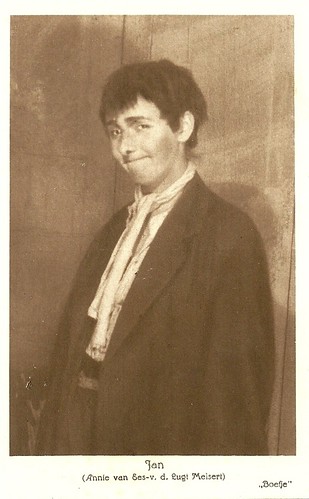
Dutch postcard by Weenenk & Snel, Den Haag. Photo: Willem Coret, Den Haag (The Hague).

Dutch postcard by Weenenk & Snel, Den Haag. Photo: Willem Coret. Still for the stage version of 'Boefje'.
Fashionable ladies and boys
Johanna Martina 'Annie' van Ees was born in Leiden in 1893. She was born into a family with five children. Her brothers, Henri van Ees and Jan van Ees, also became actors.
From early on, she knew that she wanted to be an actress, and she attended an acting school. At 17, she made her stage debut in the play 'Schakels' (Chains) by Herman Heijermans. She joined the theatre company Het Tooneel and appeared in plays like '‘t Cafétje' (The Little Café) (1912) by Tristan Bernard.
Later, she was discovered by the famous stage director Cor van der Lugt Melsert and she joined his renowned company Nederlandsch Tooneel. In 1919 the two married, and they would have one son, Cor jr. From 1922 to 1938, Annie worked for the theatre company Vereenigd Rotterdamsch-Hofstad Tooneel. She played fashionable ladies, young girls and even boys.
In 1923 she played thus the title role in the play that made her famous, 'Boefje'(Little Rascal) based on the novel by M.J. Brusse. She would appear more than 1500 times in this play. She also performed regularly in the Dutch Indies (now Indonesia). Another success was 'Leontientje', which premiered in 1926.
With her brother Jan van Ees, she appeared in the plays 'Men trouwt geen meisjes zonder geld' (Without Money One Doesn’t Marry Girls) (1929) by István Zagon, 'Mélo' (1930) by Henry Bernstein and 'De keizer van Amerika' (The Apple Cart) (1930) by George Bernhard Shaw.

Dutch postcard by N.V. Vereenigd Rotterdamsch Hofstadtoneel, Rotterdam. Photo: Willem Coret. Still for the stage version of 'Boefje'.

Dutch postcard by Vereenigd Rotterdamsch Hofstadtooneel. Photo: Willem Coret, The Hague. Publicity still for the stage play 'Boefje' (1922). Caption: "Jan in the brother's house".

Dutch postcard by Vereenigd Rotterdamsch Hofstadtooneel. Photo: Coret, The Hague. Publicity still for the stage play 'Boefje' (1922). Caption: "Jan with Mr. Halma in the courtroom".
Grande dame
During the 1930s, Annie van Ees became one of the grande dames of the Dutch stage. After she left the Vereenigd Rotterdamsch-Hofstad Tooneel, she was offered the lead role in the film version of Boefje/Wilton's Zoo (Detlef Sierck a.k.a. Douglas Sirk, 1939).
At 45, Annie played twelve-year-old Jan Grovers a.k.a. Boefje, who spends more time in the alleys of Rotterdam than with his family. Occasionally he looks after his three younger sisters, all of whom are called Mientje. Together with his best friend and partner in crime Pietje Puk (Guus Brox), he plans to travel to America to get rich. When a local clergyman (Albert van Dalsum) takes pity on the boy and tries to teach him good manners, Boefje at first rebels. However, once he is sent to a strict boarding school, he takes an interest in music, specifically the pipe organ.
Douglas Sirk wrote the scenario himself together with Carl Zuckmayer, the scriptwriter of Der blaue Engel/The Blue Angel (Josef von Sternberg, 1930) and several other classics. Annie played the cigar-smoking street kid now with a shortcut, but Sirk later said that he would have preferred to work with real children.
Later, Annie van Ees appeared on stage in the title role of 'Madame Bovary' (1942), and in 1950 she retired from the theatre. In 1970, one year after the death of her husband, Annie van Ees died in Morges, Switzerland. She was 76. In the city of Heerhugowaard, a garden is named after her, and in Rotterdam, she is honoured with the 'Annie van Eesstraat' (Annie van Ees Street).
The film version of Boefje was actually chosen to compete in the very first Cannes Film Festival that was to be held in September of 1939, but the festival was cancelled when the war broke out. However, during the 55th edition held in 2002, it was decided to screen the 7 nominated films from 1939, pitting Boefje against The Wizard of Oz, Goodbye Mr. Chips and others. The award eventually went to Cecil B. DeMille's Union Pacific (1939).

Annie's brother, Jan van Ees. Dutch postcard by Uitgave Weenenk & Snel, Den Haag. Photo: Willem Coret.

Dutch postcard. Photo: Willem Coret, Den Haag (The Hague).

Dutch postcard by NV Vereenigd Rotterdamsch Hofstadtooneel. Photo: Coret, The Hague. Annie van Ees-van der Lugt Melsert in the stage play 'Boefje'.
Sources: Chip Douglas (IMDb), Guido Franken (Neerlands Filmdoek - Dutch), Wikipedia (Dutch) and IMDb.
This post was last updated on 9 February 2024.
No comments:
Post a Comment